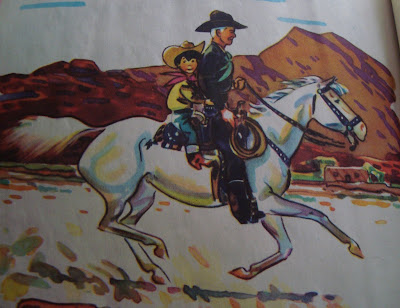
Cactus Kevin
B. Holland Heck, il. Lorence Bjorklund
1965, The World Publishing Company
"A fellow on a farm has to have a horse."It's 1944, and Kevin Bryson's parents have just moved the family from Tulsa to a farm (his dad, working at the Douglas Aircraft Company, a war industry, is presumably exempt from the draft). He's never been on a horse, and he has trouble remembering his new chores, but he loves being out in the country and once he sees a neighbor's palomino gelding, he's in love. The neighbor, a brat named Freddie, is notorious for mishandling his horse, which further inflames Kevin. But apart from the Bryson's lack of money, there's a problem in that the former city boy is fighting his parents' doubt that he is responsible enough to have a horse. From leaving the calf without water to teaching the rooster to fight, Kevin seems to constantly give his father a reason to be exasperated.

The family has problems apart from his wanting a pony they can't afford. Kevin's mother is struggling to maintain a primitive, rural house, while his father is discouraged by the sizable task of bringing a neglected farm back to life. Their worst problem is their well is dry, something the previous owner failed to mention. As the family slowly moves forward, digging a new well, buying calves, and learning the ins and outs of tractor control, Kevin is often too busy dealing with the new demands of farm life to long for a horse.
It rained again that night, making the ground muddier than ever. The Brysons scarcely knew how to cope with the mud. Dad said, "That's the blackest, stickiest, contrariest stuff I ever saw." Kevin thought both Dad and Mom seemed a little defeated by it. A variety of thin, straggly grass grew in the yard, but it didn't keep them out of the mud as their lawn grass in town had done. This grass pulled up by the roots with the mud, helping to hold the mud together that much tighter.Kevin eventually gets his chance, Freddie gets his comeuppance, and the family triumphs over their early adversity. A very solid story about a family, but not particularly horsey as most of the book is about the family's struggles with the farm. I'm a sucker for tales about Black Angus calves, tractors and digging wells, but I was a bit disappointed, especially as the few really horsey scenes are flat. There is one hair-raising accident scene, which you can see coming the first time Freddie uses his horse to race the school bus.

Like most farm books, it does an excellent job of showing the dangerous side of farming; Kevin, who rides out the above rear without turning a hair, is terrified when his father's first ride on the new tractor nearly turns to tragedy.

Heck also does a nice job of presenting realistic characters. The mother isn't saintly or silly; the little sister is bratty but strong (and Kevin swings between "Awww, sis" reactions and doing things like building her the snow horse above), and the father can get discouraged and unreasonable. Perhaps reflecting the isolation of their ranch, there are few characters outside the family, apart from old Wrangler Slim, an old man living nearby who befriends them when Kevin, early on, wanders into a cactus patch, and who gives him his nickname.
About the AuthorBessie Holland Heck based this book on her own family's adventures, and Kevin was based on her son Ronald. She was married with five children, a freelance writer who lived in Tulsa and, during World War II, on an acreage just like the Bryson family's.
Other booksMillie (1961) (il. Mary Stevens)
The Hopeful Years (1964) (il. Lorence Bjorklund)
The Year At Boggy (1966) (il. Paul Frame) - adventures of farm workers' children
Captain Pete (1967) (il. Robert Cassell)
Golden Arrow (1981) - also horsey (il. Charles Robinson) (Scribner)
Cave-In At Mason's Mine (il., Charles Robinson) (Encore Editions)
Danger On The Homestead (1991) (Levite Of Apache Publishing)
Taming The Homestead (sequel to above)
The books after 1981 appear to have been published by a very small regional publisher, and little information is available on them. All the books appear to be juvenile fiction.
Links
de Grummond Collection
Ponymad Booklovers blog on Heck
Jane Badger Books about Heck
Catoosa, OK
 E.M. Beecher, il. Sahula-Dycke
E.M. Beecher, il. Sahula-Dycke
 And then branding it neatly with my own initials.
And then branding it neatly with my own initials.

















